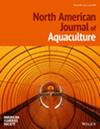海洋观赏虾虎鱼首次摄食:最佳初始活饲料生物及其摄食密度的研究
IF 1.3
4区 农林科学
Q3 FISHERIES
引用次数: 0
摘要
白条纹虾虎鱼(Amblygobius phalaena)是海洋水族市场上很受欢迎的观赏鱼。要实现成功的商业化生产,有效的幼虫饲养技术至关重要。先前的研究已经成功地在第一摄食阶段使用三种活饲料生物:纤毛虫Euplotes sp.,轮状臂轮虫和桡足类Apocyclops royi nauplii的组合培养了蝴蝶结姬蜂的幼虫。然而,这些活饲料生物对幼虫生存和生长的具体贡献尚不清楚。此外,关键初始活饲料生物的最佳饲喂密度尚未通过实验确定。在本研究中,我们旨在通过引入牡蛎trochophores和解决这些知识空白,来完善蝴蝶结沙蚕的幼虫养殖方案。实验结果表明,在第一摄食阶段,黄颡鱼幼虫可以同时食用牡蛎trochophores和Euplotes sp.。然而,以牡蛎trotrohores为食的幼虫表现出优异的生存和生长性能。牡蛎trochophores的最佳取食密度为10个(ind.)/mL,当取食密度达到20个(ind.)/mL时,幼虫取食率降低。这些发现对提高海洋观赏虾虎鱼的幼虫生产计划和促进其可持续商业化具有重要意义。本文章由计算机程序翻译,如有差异,请以英文原文为准。
First feeding of marine ornamental goby Amblygobius phalaena: investigating the optimal initial live feed organisms and its feeding density
The white-barred goby, Amblygobius phalaena, is a popular ornamental fish in the marine aquarium market. To achieve successful commercial production, efficient larval rearing techniques are crucial. Previous studies have achieved successful cultivation of A. phalaena larvae using a combination of three live feed organisms: ciliates Euplotes sp., rotifers Brachionus rotundiformis, and copepod Apocyclops royi nauplii during the first feeding stage. However, the specific contributions of these live feed organisms to larval survival and growth remain unclear. Moreover, the optimal feeding density for the critical initial live feed organism has not been determined experimentally. In this study, we aimed to enhance the larviculture protocol for A. phalaena by introducing oyster trochophores and addressing these knowledge gaps. Our experiments revealed that A. phalaena larvae could consume both oyster trochophores and Euplotes sp. during the first feeding stage. However, larva exhibited superior survival and growth performance when fed oyster trochophores. The optimal feeding density of oyster trochophores was determined to be 10 individuals (ind.)/mL, while a feeding density as high as 20 ind./mL resulted in decreased larval feeding incidence. These findings have significant implications for enhancing larval production programs of marine ornamental gobies and promoting their sustainable commercialization.
求助全文
通过发布文献求助,成功后即可免费获取论文全文。
去求助
来源期刊
CiteScore
2.50
自引率
0.00%
发文量
46
审稿时长
18-36 weeks
期刊介绍:
The North American Journal of Aquaculture publishes papers on new research and practical experience in all areas of intensive and extensive fish culture. Topics include broodstock selection and spawning, nutrition and feeding, health and water quality, facilities and production technology, and the management of ponds, pens, and raceways.
The journal will consider papers dealing with ways to improve the husbandry of any aquatic species—marine or freshwater, vertebrate or invertebrate—raised for commercial, scientific, recreational, enhancement, or restoration purposes that may be of interest to practitioners in North America. Its scope includes both basic and applied science, but applied scientific endeavors—including practical experiences, descriptive studies, and other nontraditional, but pertinent works—are emphasized.

 求助内容:
求助内容: 应助结果提醒方式:
应助结果提醒方式:


